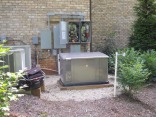
What is an automatic generator?
Generator Systems (combustion engine type)
A machine that controls the flow of electrons (electricity) to power your home, starting automatically when your utility power from your utility power company is off.
These machines utilize an engine to turn a large magnet, the rotor. The spinning magnet forces electron flow from inside another component of the generator, the stator, to electrical loads. This electron flow travels thru the conductive highways of structure, electrical circuits. An electrical circuit is simply a conductive surface area that provides a path for electron flow from a source, (the generator), to a consumer of the energy within the electron, (an electrical load), and then back to the source. Without a complete path between the source and the load, electrical flow or electricity would not exist.
Generators come in all sizes, shapes, brands, and voltage output configurations. The engines inside the generator unit come in different sizes and brands, with different fuel source requirements. Diesel, liquid propane, and natural gas are all fuels that could be used depending on the type system chosen.
Electronics and sometimes complex wiring harnesses are used to make sure the voltage output is safe and useful by regulating engine speed and how much excitation is used.
Transfer switches, an important part of a generator system are used to connect your structure to either utility (power company source) or to the generator. These switches make sure the two sources do not connect to each other which would be bad for several reasons. Transfer switches are either manual or automatic but increasingly more, most used are automatic.
For automatic systems, potential load connection calculations or a measurement of what could potentially connect to the generator source with reference to energy comsumption, is needed and now required by electrical codes.
There is a lot that goes into moving an electrons whose purpose is to provide energy for conveniences we use in our daily lives, energy that illuminates a light bulb, energy that provides, allows mechanical action to transfer heat from inside to outside structure (air conditioning), with enough capacity to provide for all your electrical needs during any type power outage.







